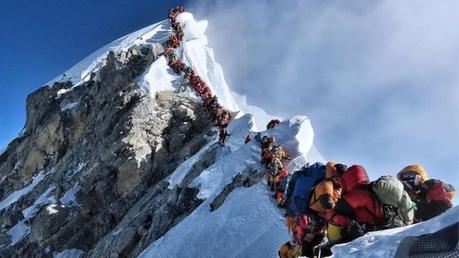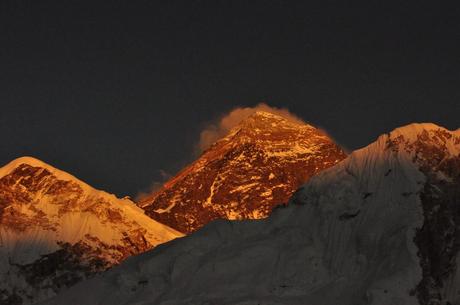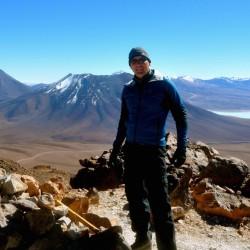After the entire spring climbing and trekking season was canceled last year due to the coronavirus pandemic, Nepal is eager to reopen its borders and welcome foreign visitors in 2021. After all, tourism accounts for a large portion of its economy and when travel came to a standstill, many Nepalis found themselves scrambling to make a living.
This year, it is full steam ahead in the Himalaya, with numerous expeditions planned for major Himalayan peaks. But just ahead of the much-anticipated influx of climbers and hikers, the Nepali Ministry of Tourism has announced a list of new rules for climbing Everest and other mountains, not all of which make a whole lot of sense.

No Photo Sharing Allowed
Without a doubt the most memorable image from the 2019 Everest climbing season was a shot taken by Nims Purja, the Nepali mountaineer who set a speed record for climbing all 14 8000-meter peaks that year. The photo, which was taken while Purja waited below the Hillary Step on the South Side of Everest, shows a long line of climbers waiting for their chance to go up to the summit. That one photo-which you can see above-made headlines around the globe and turned renewed spotlight on issues of overcrowding on the world's highest peak. It was also a source of embarrassment for Nepal.
For years climbing experts have called on the Nepali government to take steps to limit the number of people on Everest each spring. But selling permits to climb the mountain is a lucrative business that local bureaucrats have little interest in slowing down. So rather than confront the dangers of overcrowding head on, the Ministry of Tourism has instead elected to ban the sharing of photos from the mountain instead.
In new rules released last week, the MoT has made it clear that while climbers are allowed to take and share photos and videos of themselves and their team, they are expressly forbidden from sharing images of anyone else. Furthermore, any images or videos that contain people, avalanches, or dead bodies must be approved by the ministry before being posted on blogs, social channels, or other media outlets.

Enforcing an Old Rule
According to Nepali officials, this "no photo sharing" rule is not new, it just hasn't been enforced in the past. This year, the government intends to crack down on climbers who post images from the mountain however, although how they intend to do that isn't exactly clear. In an age of connected smartphones-there is cell service in Everest base camp after all-and satellite internet, preventing images and video from leaking out seems nearly impossible.
"Each climber can take, share and make images and videos of their group or of oneself but they will face action if they take, make and share photos of other climbers without the department's consent," Mira Acharya-the director at the Mountaineering Division of the Department of Tourism- told The Kathmandu Post. "We honour the personal freedom of climbers but that does not mean they can post images and videos of others without their consent. Either through commercial cameras or mobile sets, all such activities have been banned."
What actions will be taken against anyone who ignores these rules is unclear, but the Nepali government has banned climbers for disobeying rules in the past. It is possible that those who ignore the regulations could face fines, detention, or the suspension of their climbing permit, although that remains to be seen.

Other Rules for Climbing Everest
Most of the other new rules for climbing Everest are designed to address other concerns that have surrounded the mountain in recent years. For instance, all climbers are required to provide a medical report from a doctor certifying that they are mentally and physically fit enough to be there. This is meant to address concerns that inexperienced and ill-prepared individuals have been attempting Everest in recent years.
All climbers are also now required to provide a full itinerary of their travel plans, both before and after their expedition. That includes setting up a post-climb debrief with Nepali officials who will expect a detailed report of the expedition. That report should include the number of days in base camp, the route taken to the summit, the dates they visited the high camps, and whether or not the climbers used supplemental oxygen. The goal here is to cut down on falsified summit claims and keep more detailed records of who did and didn't complete the climb.
One other rule of note directs all helicopter rescue operations to fly climbers seeking medical attention to an airport rather than a hospital. A series of high-profile travel insurance scams has been a black mark on Nepal's reputation in recent years and this particular regulation is designed to prevent that from continuing.
Will These Regulations Matter?
Anyone who has any familiarity with politics in Nepal or follows the Everest climbing scene knows that these kinds of regulations are not new. For years, government officials have made similar decrees, often in the name of safety. Rarely have they ever been enforced however and more often then not they end up being ignored altogether. It remains to be seen whether or no 2021 will be any different.
If Nepal truly wants to get serious about making Everest safer it needs to stop worrying about what photos are shared and start regulating the number of people on the mountain. Scaling back the number of permits and requiring climbers to scale another Himalayan peak before going to the Big Hill make perfect sense. Of course, this is the Nepali government we're talking about here, so that seems unlikely to happen.
We'll know a lot more about how seriousness they are about enforcing these regulations in a few weeks. With the 2021 spring climbing season about to begin, many of us will be eager to follow along for a number of reasons.



